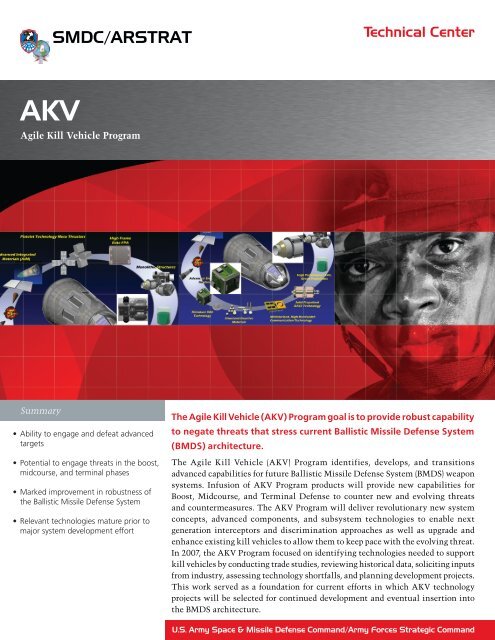Agile Kill Vehicle Program - Space and Missile Defense Command ...
Agile Kill Vehicle Program - Space and Missile Defense Command ...
Agile Kill Vehicle Program - Space and Missile Defense Command ...
You also want an ePaper? Increase the reach of your titles
YUMPU automatically turns print PDFs into web optimized ePapers that Google loves.
SMDC/ARSTRAT<br />
Technical Center<br />
AKV<br />
<strong>Agile</strong> <strong>Kill</strong> <strong>Vehicle</strong> <strong>Program</strong><br />
Summary<br />
• Ability to engage <strong>and</strong> defeat advanced<br />
targets<br />
• Potential to engage threats in the boost,<br />
midcourse, <strong>and</strong> terminal phases<br />
• Marked improvement in robustness of<br />
the Ballistic <strong>Missile</strong> <strong>Defense</strong> System<br />
• Relevant technologies mature prior to<br />
major system development effort<br />
The <strong>Agile</strong> <strong>Kill</strong> <strong>Vehicle</strong> (AKV) <strong>Program</strong> goal is to provide robust capability<br />
to negate threats that stress current Ballistic <strong>Missile</strong> <strong>Defense</strong> System<br />
(BMDS) architecture.<br />
The <strong>Agile</strong> <strong>Kill</strong> <strong>Vehicle</strong> (AKV) <strong>Program</strong> identifies, develops, <strong>and</strong> transitions<br />
advanced capabilities for future Ballistic <strong>Missile</strong> <strong>Defense</strong> System (BMDS) weapon<br />
systems. Infusion of AKV <strong>Program</strong> products will provide new capabilities for<br />
Boost, Midcourse, <strong>and</strong> Terminal <strong>Defense</strong> to counter new <strong>and</strong> evolving threats<br />
<strong>and</strong> countermeasures. The AKV <strong>Program</strong> will deliver revolutionary new system<br />
concepts, advanced components, <strong>and</strong> subsystem technologies to enable next<br />
generation interceptors <strong>and</strong> discrimination approaches as well as upgrade <strong>and</strong><br />
enhance existing kill vehicles to allow them to keep pace with the evolving threat.<br />
In 2007, the AKV <strong>Program</strong> focused on identifying technologies needed to support<br />
kill vehicles by conducting trade studies, reviewing historical data, soliciting inputs<br />
from industry, assessing technology shortfalls, <strong>and</strong> planning development projects.<br />
This work served as a foundation for current efforts in which AKV technology<br />
projects will be selected for continued development <strong>and</strong> eventual insertion into<br />
the BMDS architecture.<br />
U.S. Army <strong>Space</strong> & <strong>Missile</strong> <strong>Defense</strong> Comm<strong>and</strong>/Army Forces Strategic Comm<strong>and</strong>
AKV<br />
Technical Center<br />
<strong>Agile</strong> <strong>Kill</strong> <strong>Vehicle</strong> <strong>Program</strong><br />
Overview<br />
The U.S. Army <strong>Space</strong> <strong>and</strong> <strong>Missile</strong> <strong>Defense</strong> Comm<strong>and</strong>/<br />
Army Forces Strategic Comm<strong>and</strong>, under the direction of the<br />
<strong>Missile</strong> <strong>Defense</strong> Agency’s (MDA’s) Advanced Technology<br />
Directorate (MDA/DV), is pursuing technologies to enable<br />
development of new systems that will form the cornerstone<br />
of enhanced capabilities to defeat advanced countermeasures<br />
<strong>and</strong> advanced targets. The <strong>Agile</strong> <strong>Kill</strong> <strong>Vehicle</strong> <strong>Program</strong><br />
is developing tomorrow’s kill vehicle technologies <strong>and</strong><br />
system concepts for potential integration into the Ballistic<br />
<strong>Missile</strong> <strong>Defense</strong> System in order to ensure the system<br />
continues to outpace the evolving ballistic missile threat.<br />
The program addresses critical needs identified by systems<br />
engineering studies based on current <strong>and</strong> postulated threat<br />
capabilities. The program’s primary focus is on maturing<br />
<strong>and</strong> delivering technologies to enable development of next<br />
generation interceptors <strong>and</strong> discrimination approaches.<br />
Benefits for Tomorrow’s <strong>Defense</strong><br />
• Ability to engage <strong>and</strong> defeat advanced targets<br />
• Potential to engage threats in the boost, midcourse, <strong>and</strong><br />
terminal phases<br />
• Marked improvement in robustness of the Ballistic<br />
<strong>Missile</strong> <strong>Defense</strong> System<br />
• Relevant technologies mature prior to major system<br />
development effort<br />
Technical Concept<br />
Today’s BMDS interceptors were not designed to engage<br />
<strong>and</strong> defeat advanced threats. In order to address the emergence<br />
of advanced threats, lightweight, lethal kill vehicles<br />
will be required. The program will address the following<br />
barriers to developing kill vehicles with the lethality <strong>and</strong><br />
performance to address advanced threats:<br />
• Materials <strong>and</strong> integration processes are not available to<br />
produce robust kill vehicle structures in the size needed<br />
to facilitate the agility required to address advanced<br />
threats<br />
• Seekers of the size needed are not available with the<br />
required field of view<br />
A robust Multi-Discipline Optimization methodology will<br />
be utilized during the design phase of AKV. Multi-Discipline<br />
Optimization methods are used where the engineering design<br />
space spans a number of technical disciplines, where<br />
the technology choices may be large, <strong>and</strong> in situations where<br />
there may be conflicting requirements or where special<br />
synergistic effects among technologies may exist. The most<br />
innovative aspect of this next generation multi-discipline<br />
optimization <strong>and</strong> design tool will be use of a Genetic Algorithm<br />
(GA) search engine to provide an efficient means<br />
of technology selection <strong>and</strong> interceptor concept synthesis.<br />
GAs were developed as part of the broad field of artificial<br />
intelligence in the 1980s. GA-based design <strong>and</strong> assessment<br />
tools have also been applied to the missile axial propulsion<br />
<strong>and</strong> aerodynamic design problems for tactical missile missions.<br />
A GA-based, endo-atmospheric interceptor optimization<br />
tool was developed in 1999 <strong>and</strong> is being updated <strong>and</strong><br />
exp<strong>and</strong>ed for the <strong>Agile</strong> <strong>Kill</strong> <strong>Vehicle</strong> design process. This<br />
optimization tool will also include embedded cost <strong>and</strong> performance<br />
simulation models which will provide a powerful,<br />
new, beyond the state-of-the-art capability to the designer.<br />
The outputs of this tool will allow program officials <strong>and</strong><br />
engineers to identify those technologies <strong>and</strong> concepts with<br />
the greatest potential for improved performance at lower<br />
cost for c<strong>and</strong>idate insertion into the future BMDS architecture.<br />
• Divert <strong>and</strong> attitude control systems which can produce<br />
the required performance are far too large <strong>and</strong> heavy to<br />
be used in a lightweight kill vehicle<br />
www.smdc.army.mil<br />
For more information, please contact:<br />
U.S. Army <strong>Space</strong> <strong>and</strong> <strong>Missile</strong> <strong>Defense</strong> Comm<strong>and</strong>/<br />
U.S. Army Forces Strategic Comm<strong>and</strong><br />
P.O. Box 1500<br />
ATTN: (SMDC-PA), Bldg. 5220<br />
Huntsville, AL 35808<br />
Phone: 256-955-3887<br />
Fax: 256-955-1214<br />
Email: webmaster@smdc.army.mil<br />
www.smdc.army.mil<br />
Distribution A 0308/0161
















